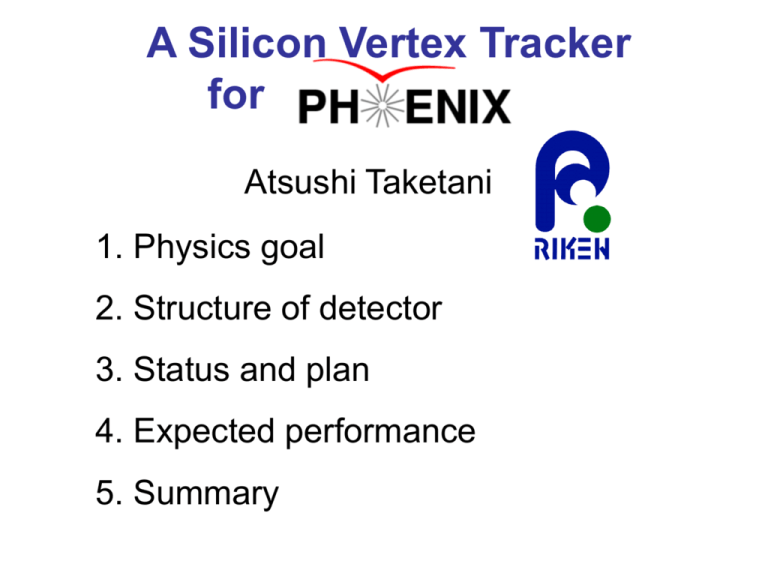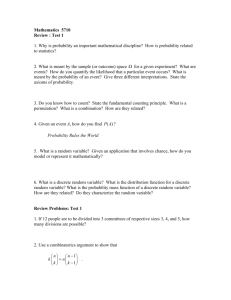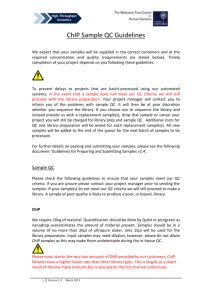ppt - Quark Matter 2005
advertisement

A Silicon Vertex Tracker for Atsushi Taketani 1. Physics goal 2. Structure of detector 3. Status and plan 4. Expected performance 5. Summary PHENIX Vertex Group (86 Participants from 15 institutions) M. Baker, R. Nouicer, R. Pak, A. Sukhanov, P. Steinberg, Z Chai Brookhaven National Laboratory, Chemistry Department Z. Li Brookhaven National Laboratory, Instrumentation Division J.S. Haggerty, J.T. Mitchell, C.L. Woody, E. O’Brien, D. Lynch Brookhaven National Laboratory, Physics Department A.D. Frawley Florida State University J. Crandall, J.C. Hill, J.G. Lajoie, C.A. Ogilvie, A. Lebedev, H. Pei, J. Rak, G.Skank, S. Skutnik, G. Sleege, G.Tuttle Iowa State University, Ames, M. Tanaka KEK N. Saito, M. Togawa, M. Wagner Kyoto University H.W. van Hecke, G.J. Kunde, D.M. Lee, M. J. Leitch, P.L. McGaughey, W.E. Sondheim Los Alamos National Laboratory T. Kawasaki, K. Fujiwara Niigata University T.C. Awes, M. Bobrek, C.L. Britton, W.L. Bryan, K.N. Castleberry, V. Cianciolo, Y.V. Efremenko, K.F. Read, D.O. Silvermyr, P.W. Stankus, A.L. Wintenberg, G.R. Young Oak Ridge National Laboratory Y. Akiba, J. Asai, H. En’yo, Y. Goto, J.M. Heuser, H. Kano, H. Ohnishi, V. Rykov, T. Tabaru, A. Taketani, K.Tanida, J. Tojo, Y. Onuki RIKEN S. Abeytunge, R. Averbeck, K. Boyle, A. Deshpande , A. Dion, A. Drees, T.K. Hemmick, B.V. Jacak, C. Pancake, V.S. Pantuev, D. Walker Stony Brook University B. Bassalleck, D.E. Fields, M. Malik, C. Hagemann University of New Mexico O. Drapier, F. Fleuret, M.Gonin, R. G. de Cassagnac, A. Romana E. Tujuba Eole Polytechnique K. Kruita, Y. Inoue Rikkyo Univesity Physics Goals Open up new horizon! Heavy Ion program Spin program • Potential enhancement of charm production. • Open beauty production. • Flavor dependence of jet quenching and QCD energy loss. • Beauty and charm separation • Accurate charm reference for quarkonium. • Thermal dilepton radiation. • Upsilon spectroscopy, e+edecay channel • g -Jet correlation • Investigating nucleon spin structure by polarized protonproton collider to utilize quark/gluon as probe, instead of DIS lepton. • gluon polarization by using beauty / charm final state. • gluon polarization by using g + jet final state. • Flavor decomposition by using W->e channel. Physics Goal Spin Program V2 b contribution ? Gluon Polarization Heavy Ion Program Pt [GeV] Charm and bottom identification by displaced vertex Jet identification with larger acceptance NSAC recommendation October 7, 2004 Within a constant level of effort budget, the Subcommittee recommends that certain essential investments be made. These include: Construction of the PHENIX Silicon Vertex Tracker and the STAR Time-of-Flight Barrel; Participation in the LHC Heavy-Ion program; Investment in RHIC accelerator and detector R&D; Construction of the EBIS; Support at the present level for university and national laboratory research; Provision for RHIC running time sufficient to preserve the integrity of the Heavy-Ion and Spin Physics programs. Current PHENIX Pioneering High Energy Nuclear Interaction eXperiment PHENIX Detector Si Vertex Tracker 1 Central Arm e, g, Charged Hadrons detection |h|<0.35, Df=p 2, Muon Arm m detection 1.2<|h|<2.4, 2p in f 3, Forward detectors Luminosity Monitoring Centrality Local polarimetery Good particle identification (But no direct b/c identification) High Rate and High Detector granularity. Limited geometrical coverage (Not 2p in central region) Requirements for Vertex Tracker Physics side • High precision tracking for displaced vertex measurement. 40mm displaced vertex resolution, ct ~ 100mm(D), ~400mm(B) • Large coverage tracking capability with momentum resolution (|h|<1.2 , and full azimuthally with s/P ~ 5%P) Environment side • • • • High charged particle density ‘dN/dh’ ~ 700 @h=0 High Radiation Dose ~100KRad@10Years High Luminosity 2 1032 cm 2 s 1 @PP -> High rate readout Low Material Budget <- avoid multiple scattering and photon conversion for electron measurement by outer detectors. Structure Barrel region • |h|<1.2, almost 2p in f • Pixel sensor at inner 2 layers • Strip sensors at outer 2 layers Forward region • 1.2<|h|<2.7, 2p in f • 4 layers of mini strip (50 x 2000 to 11000 mm) • Trigger capable Strip R=10 and 14cm Pixel Poster by K.Fujiwara(#292) D.E.Field (#290) R=2.5 and 5cm Poster by G.J.Kunde(#297) PIXEL (Sensor and Readout) Pixel size( x z) 50 µm x 425 µm Sensor Thickness 200um r = 1.36cm, z = 1.28 cm 256 x 32 = 8192 channel / sensor 4 sensor / chip 4 chip / ladder Readout by ALICE_LHCB1 chip • Amp + Discriminator / channel •Bump bonded( 2 dim. Soldering) to each pixel •Running 10MHz clock ( RHIC 106nsec ) •Digital buffer for each channel > 4usec depth •Trigger capability > FAST OR logic for each crossing Used at NA60 (Rad hard) PIXEL readout Al-Kapton Bus readout to minimize material (120micron pitch ) 15μm PIXEL readout Pilot module 4x parallel readout 32 256 128bit width bus Ver.1 is running. Ver.2 will come in Summer PHENIX Digital Pilot •ALICE chip is 32bit input/40MHz x 16bit output •New chip is 64bit input/40MHz x 32bit output Strip layer Two strip-pixel arrays on a single-sided wafer of 500 µm thickness, with 384 + 384 channels on 3 x 3 cm2 area. Sensor elements: Initial design: “longitudinal” readout. Made by SINTEF Pixels: 80 µm 1 mm, projective readout via double metal XU/V “strips” of ~3 cm length. Developed at BNL Instrumentation Gr. Single sided new design: “lateral” SVX4 readout. Made by Hamamatsu 1+1 dimensional readout 3cmx3cm sensor x2 / chip ( X and U direction) 768 X strip and 768 U strips/chip Position resolution is 25mm by test beam Strip Readout “RC Chip” “RC Chip” “RC Chip” “RC Chip” “RC Chip” “RC Chip” SVX4 U1 SVX4 X1 SVX4 X2 SVX4 X6 SVX4 U6 SVX4 U5 Control signal daisy-chain RCC Power daisy-chain Data signal daisy-chain SVX4 U2 SVX4 U3 SVX4 X3 SVX4 X5 SVX4 X4 SVX4 U4 “RC Chip” “RC Chip” “RC Chip” “RC Chip” “RC Chip” “RC Chip” SVX4 Readout chip Developed by FNAL for TEVATRON RUN2b (Rad hard) 8 bit ADC for each channel 128 channel per chip Readout3cm Testx6cm boardsensor (Testing now) 3 SVX Chip Packing factor is same Control by onboard FPGA Schedule and status • • • • • • • Pixel Readout test End of 2005 Strip Readout test Fall of 2005. Structure design study Start now Prototype ladder Early 2006 Production (Japan) Start in 2005 Production (US) 2007 Installation complete 2009 (Possible early partial implementation) • Total cost ~8M US$ (Japan, US, France) Expected Performance D0 decay Collision Vertex Layer radius Sensor Occupancy Layer 1 2.5 cm Pixel 0.53 % Layer 2 5.0 cm Pixel 0.16% Layer 3 10.0 cm Strip Layer 4 14.0 cm Strip 4.5 % 4.7 % (x-strip) (u-strip) 2.5 % 2.7 % (x-strip) (u-strip) Expected occupancy at Au-Au 200GeV most central event Distance to the Closest Approach [cm] Spin performance parton X reconstruction by g + Jet Using only Photon information Photon + 2p VTX tracker Great improvement with VTX Summary • PHENIX Silicon Vertex Tracker will open new physics horizon for both Heavy Ion and Spin program of RHIC. • There are two of inner pixel layers, two of outer strip layers and forward mini-strips • Hardware R&D work is on going. • Completer installation in 2009 for RHIC RUN9(2009/2010). • Plans underway for early partial implementation. Related Posters Forward Silicon G.J. Kunde (#297) Pixel Layer K. Fujiwara(#292) Strip Layer D.E. Field (#290) Structure summary (Backup) VTX Layer R1 R2 R3 R4 Geometrical dimensions R (cm) 2.5 5 10 14 z (cm) 21.8 21.8 31.8 38.2 Area (cm2) 280 560 1240 1600 Sensor size R z (cm2) 1.28 1.36 (256 × 32 pixels) 3.43 × 6.36 (384 × 2 strips) Channel size 50 425 mm2 80 mm 3 cm (effective 80 1000 mm2) Sensors/ladder 28 Channel count Radiation length (X/X0) 5 6 Ladders 10 20 18 26 Sensors 160 320 90 144 Readout chips 160 320 1080 1728 Readout channels 1,310,720 2,621,440 138,240 221,184 Sensor 0.2% 0.5 % Readout 0.16% 0.8 % Bus 0.14% Ladder & cooling 0.7% 0.7 % Total 1.2% 2.0 %







